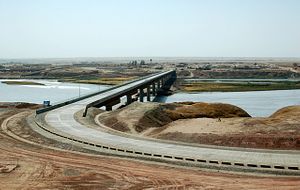The Turkmen-Afghan border is, understandably, one of the least-covered geopolitical divides extant. It’s also one of the most peculiar. For years, the Amu Darya River – one of the points of separation between Afghanistan and the Soviet Union, and now between Kabul and Ashgabat – has been steadily pushing southward, eroding Afghan land and creating unmarked islands along the way. As the years have passed, the split between borders on the map and borders on the ground has only grown.
The border region has been relatively quiescent over the past few years but in 2014 things shifted. Incidents between Turkmen border guards and local Afghan actors, Taliban and non-Taliban alike, flared. Afghans claimed Turkmen nationals were stealing their land. Turkmen guards claimed they were simply protecting their de facto border. Multiple deaths, numerous incidents, and smothered protests have lined the disputed border over the past twelve months, and there’s little sign of restitution on the horizon.
And now there may be other factors to consider along the border. It is clear the Turkmenistani government doesn’t feel nearly as confident against putative Islamist threats as it would like. (An internationally acknowledged regime of neutrality will not stop Islamic militants, after all.) To be sure, the threat that ISIS poses to Central Asia, and to Turkmenistan especially, is significantly overblown by both Moscow and Washington. Even Afghanistan has amped the threat, with President Ashraf Ghani this week saying ISIS presented a “terrible threat” to Central Asia.
But between call-ups and troops movements aiming at shoring up the border with Afghanistan, Ashgabat is clearly rattled. Which makes recent reports of Uzbekistani and Russian troops along the Turkmen-Afghan border that much more plausible. Earlier this month, Chronicles of Turkmenistan reported that border residents spotted Uzbekistani contingents near the border. (Whether they were sporting new, U.S.-provided MRAPs remained unclear.) Likewise, “military instructors” from Russia also reportedly appeared.
No independent verifications have yet come out, and one source in the country told me that reports of foreign boots weren’t true. (Neither Turkmenistan nor Uzbekistan are members of the Russia-led CSTO.) But even if the rumors are just that, they help point to Turkmenistan’s sudden concerns about its southern flank – and help play into the narrative of ISIS’s burgeoning presence in Afghanistan. It’s this narrative that has allowed Russia to strengthen its military capabilities in Kyrgyzstan and Tajikistan, and which has allowed Central Asian governments to ramp up their media and security clampdowns that much more over the past few months.
The Turkmen-Afghan border, where farmers and local guards had prior been scrapping for shifting island outposts, was already one of the most peculiar in the region. With the added threats, however fabricated, of Islamist spillover now increasing, the border’s set to become that much more interesting.

































